Willow Creek Blu-ray Movie
HomeWillow Creek Blu-ray Movie 
MPI Media Group | 2013 | 80 min | Not rated | Sep 09, 2014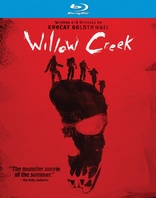
Price
List price:Third party: $13.99 (Save 53%)
Listed on Amazon marketplace
Buy it from YesAsia:
Movie rating
5.9 | / 10 |
Blu-ray rating
| Users | 4.0 | |
| Reviewer | 3.0 | |
| Overall | 3.6 |
Overview
Willow Creek (2013)
Jim and his girlfriend, Kelly, are visiting the infamous region near Willow Creek, home of the original Bigfoot legend, which Jim is keen to explore and capture on camera. Isolated among the dark and silent woods, neither Kelly or Jim is prepared for what they encounter.
Starring: Alexie Gilmore, Bryce Johnson, Peter JasonDirector: Bobcat Goldthwait
| Horror | Uncertain |
| Thriller | Uncertain |
| Adventure | Uncertain |
| Mystery | Uncertain |
Specifications
Video
Video codec: MPEG-4 AVC
Video resolution: 1080p
Aspect ratio: 1.78:1
Original aspect ratio: 1.78:1
Audio
English: DTS-HD Master Audio 5.1 (48kHz, 16-bit)
English: LPCM 2.0 (48kHz, 16-bit)
Subtitles
English SDH
Discs
25GB Blu-ray Disc
Single disc (1 BD)
Playback
Region A (C untested)
Review
Rating summary
| Movie | 2.5 | |
| Video | 4.0 | |
| Audio | 4.5 | |
| Extras | 3.0 | |
| Overall | 3.0 |
Willow Creek Blu-ray Movie Review
The Truth Is Out There (In the Woods)
Reviewed by Michael Reuben September 2, 2014As former standup comic Bobcat Goldthwait pursues his second career as a filmmaker, he continues experimenting with genres and formats, always leaving his individual stamp so that everything he tries comes out a little (and sometimes a lot) skewed from the mainstream. Willow Creek is Goldthwait's attempt at a "found footage" horror film, and it has the distinction of being made by someone who, at least initially, thought the "found footage" gimmick had been exhausted (a sentiment shared by many moviegoers). Goldthwait credits filmmaker and horror afficionado Joe Lynch (Holliston) with persuading him that there was still room for innovation in the technique. So if your first reaction to Willow Creek is "Not another one!", blame Lynch. Goldthwait's solution to the many artificialities that bothered him in found footage films was to make Willow Creek the product of an amateur documentary filmmaker obsessed with Bigfoot—specifically, with the famous image captured in 1967 by Roger Patterson and Robert Gimlin in the remote California region of Bluff Creek. Setting out to retrace the footsteps of Patterson-Gimlin, the filmmaker finds that the surrounding region is now a virtual theme park devoted to Bigfoot. It's an intriguing idea, and it has the virtue of being true. The sets and locations already exist. The notion of creating a found footage film from a would-be documentary isn't new. Among other examples, director Ti West used the same technique in The Sacrament. The peculiar spin in Willow Creek is that the "documentary" is an amateur creation made strictly for fun. It may never have been intended for anything except private viewing among friends. No one is more shocked than the amateur Bigfoot buff when he ends up finding far more than even Patterson and Gimlin ever imagined.
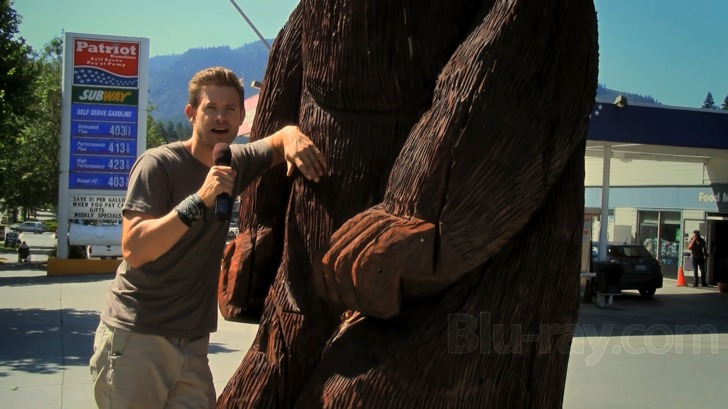
Although a number of people appear in small roles, Willow Creek is essentially a two-character film featuring Kelly (Alexie Gilmore, World's Greatest Dad) and Jim (Bryce Johnson, Pretty Little Liars), a couple who set off to fulfill Jim's dream of retracing the steps of Patterson and Gimlin. It's a longtime ambition of Jim's to film this quest, and Kelly, who doesn't believe in Bigfoot, is accompanying her boyfriend as a birthday present. Their ultimate destination is the Patterson-Gimlin site in Bluff Creek, which can only be reached by an arduous hike through dense forest. First, however, they drive to the nearby town of Willow Creek, shoot the local sights and interview whoever will talk to them. Goldthwait's original was a Christopher Guest-style mockumentary about Bigfoot enthusiasts, because it's such a distinctive world. Traces of that initial inspiration are detectable in the first half of the film, as Kelly and Jim take in the unique sights of a town where Bigfoot tourism has become a major industry. The many statues and tourist attractions, including, for example, the Big Foot Burger that arrives on a giant footprint-shaped bun, make for entertaining viewing, especially when seen through the eyes of Kelly and Jim, whose banter represents a typical outsider's point of view. The interviews with real locals are equally fun, as Jim's little-kid enthusiasm contrasts with the calm, even bored demeanor of people for whom Bigfoot lore is just an everyday thing. The atmosphere changes when Kelly and Jim head for the Patterson-Gimlin site. Although they have been warned that many of the local people are unfriendly, they are unprepared for the angry reception they receive from a man standing where the road ends, as if on guard (the actor's name, appropriately enough, is Bucky Sinister). Thanks to Jim's many hours of intensive study, they find an alternative point of entry and begin the long hike toward the Mecca of Bigfoot enthusiasts, pitching camp for an overnight stay, which is where strange events begin. Some can be attributed to animals (and one forest creature makes a surprise appearance), but others are harder to explain. In director Goldthwait's most daring (and questionable) decision, Kelly and Jim are awakened at night by disturbing sounds and proceed to huddle in their tent with their camera turned on, while all manner of bizarre occurrences happen around them. I probably wouldn't venture outside either, but it's a very long shot, almost a quarter of the movie. As good as the performances by Gilmore and Johnson are, modern audiences can't be expected to sit still for nineteen minutes for what amounts to a radio play. (The sound editing in this sequence is superb.) Do Kelly and Jim eventually find Bigfoot? You could say that they do. Bear in mind that Jim wanted to follow in the footsteps (if you'll forgive the phrase) of Patterson and Gimlin, and their famous image was just one frame of film. To see what Kelly and Jim discover, you may need to freeze the image. (And no, it doesn't appear in the screenshots.)
Willow Creek Blu-ray Movie, Video Quality 
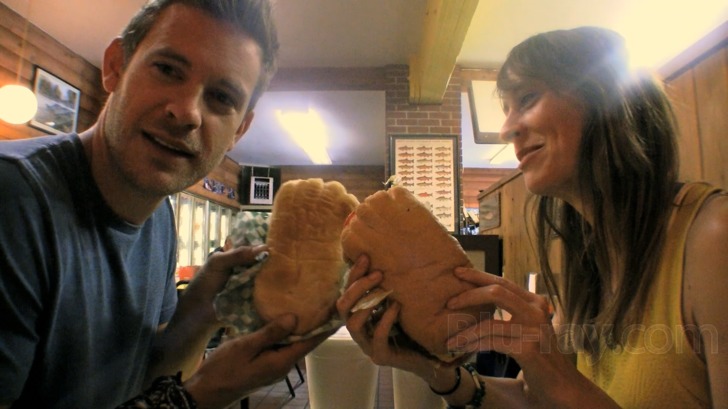
Willow Creek is the first feature shot by cinematographer Evan Phelan, using a digital camera of unspecified make and model. True to the "found footage" aesthetic, the camerawork has deliberately been made to look amateurish, but in fact it is far more professional than most amateurs could manage. The focus remains tight, and the framing is precise, so that the image on MPI Media's 1080p, AVC-encoded Blu-ray retains the usual benefits of digital capture: a sharp, crisp image; well-rendered detail; mostly solid blacks (with exceptions noted below); and generally good color rendition, although the post-production process has achieved the naturalistic look of a home-made recording shot on the fly without the benefit of professional lighting. Still, the dense growth of the forest is a rich green, and some of the California country landscapes are stunning. The lengthy nighttime sequence in which Kelly and Jim huddle in their tent is an exception to the above, but it is so by design. With just a single light source from the camera to illuminate them, the image is somewhat fuzzy and alive with video noise (if this were film, we'd call it "grainy"). The blackness surrounding them also shifts back and forth among various shades and tones of black in what is sometimes called "crushing" but is in fact the exact opposite. ("Crushed" blacks have no differentiation between levels of black.) Again, all of this is by design and not a fault in the Blu-ray. Because the film is short and the video extras are minor, MPI has delivered an average bitrate of 29.99, which is excellent. Despite the fact that a quarter of the film consists of a single shot with apparently very little movement, the video complexity of that shot requires substantial bandwidth.
Willow Creek Blu-ray Movie, Audio Quality 
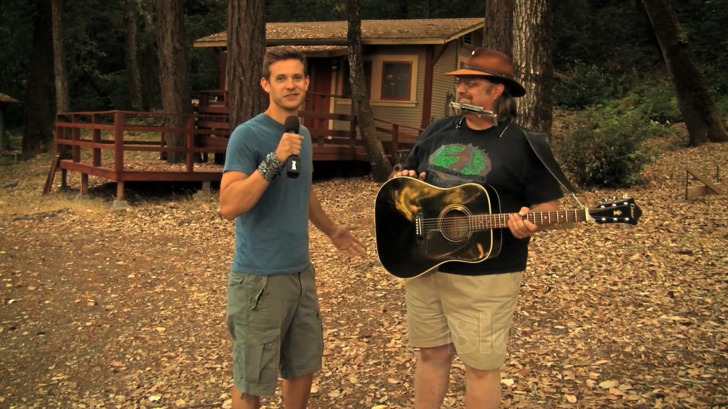
If you listen to the wind whipping around the microphone in some of the extras, particularly the deleted scene, it immediately becomes evident how much work went into crafting Willow Creek's 5.1 soundtrack, presented on Blu-ray in lossless DTS-HD MA. Clearly, much of the dialogue had to be reconstructed in ADR or, for those participants who were unavailable, heavily filtered to remove background noise. As for the remainder of the track, here again the "found footage" aesthetic limits the degree to which the 5.1 surround field can be used, at least until Kelly and Jim find themselves alone at night in the woods, at which point suspension of disbelief kicks in and the soundtrack comes alive with increasingly frightful effects: footsteps, vocalizations, impacts (I don't want to be more specific) and other sounds that are difficult to characterize. (On the commentary, the participants reveal that Goldthwait supplied several of them.) The film has no music, except for a brief performance by local folk singer Tom Yamarone, who is one of Jim's interviewees, an impromptu ukelele performance by one of the crew and a closing number over the credits that I will leave for the viewer to discover.
Willow Creek Blu-ray Movie, Special Features and Extras 
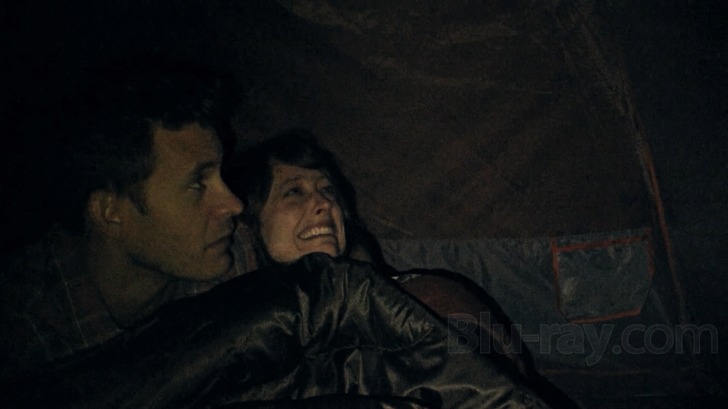
- Commentary with Writer/Director Bobcat Goldthwait and Stars Alexie Gilmore and Bryce Johnson: Two major themes emerge from this chatty, informal commentary recorded in Goldthwait's living room. One is the physical rigors of shooting Willow Creek in the actual locations where the film takes place. The other is Goldthwait's determination not to fall into some of the sloppier conventions of "found footage" films, which is why, for example, the film has as few edits as possible.
- Cliff Barackman's Deleted Scene (1080p; 1.78:1; 4:32): Barackman is an established Bigfoot researcher. I suspect his scene was dropped because the directions he gives Jim are extremely technical and detailed, but there's an interesting moment near the end, when he reassures Kelly that "bigfooting" isn't a dangerous pursuit.
- Bryce Johnson's "The Making of Willow Creek" (1080p; 1.78:1; 11:27): The title is misleading, because this featurette covers only part of one day near the end of shooting, as Johnson records the painstaking process of creating the footprints that Kelly and Jim find near a river bank.
- Trailer (1080p; 1.78:1; 1:45): "In 1967 Bigfoot was first filmed near Willow Creek, California. There have been no other recorded images. Until now."
- Additional Trailers: At startup the disc plays trailers for the remastered Texas Chainsaw Massacre and LFO: The Movie, which can be skipped with the chapter forward button and are not otherwise available once the disc loads.
Willow Creek Blu-ray Movie, Overall Score and Recommendation 

There is much to admire in Willow Creek, especially how writer/director Goldthwait has incorporated the existing lore of Bigfoot into the story in a way that not only supports the narrative but lures the characters further into trouble. But Goldthwait may have gone too far with his self-imposed found footage "vow of chastity", especially in the film's second half. The first half itself is already a lengthy buildup, and too many viewers are likely to feel let down by a second half that is, in effect, a different form of buildup, as the now-terrified adventurers cower before the camera. It has become a cliché that modern horror directors rely too much on the shock effect of a sudden edit, but Goldthwait in Willow Creek goes in the opposite direction. He's so afraid of creating an edit that wouldn't exist in "real" found footage that he won't cut when he probably should. The sequence didn't work for me, even with the film's impressive ending as a payoff. You may feel differently. Buyer's choice.
Similar titles
Similar titles you might also like

Pyewacket
2018

Grizzly
1976

Bigfoot: The Lost Coast Tapes
2012

The Reptile
1966

Wendigo 4K
2001

Equinox
1970

Slender Man
2018

The Other Side of the Door
2016

Antibirth
2016

Bite
2015

Ghostkeeper
1981

Cabin Fever: Patient Zero
2014

Cold Skin
2017

V/H/S/2
Unrated Theatrical and Rated Versions
2013

Darlin'
2019

Lifechanger
2018

The Pack
2015

Before I Wake
2016

Animal
2014

American Mary
2012